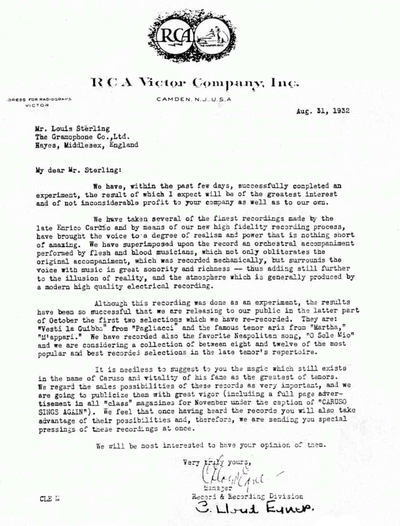|
Enrico Caruso: the electrical recordings
by Barry R. Ashpole
Unquestionably, more biographies, discographies,
essays, and the like, have been written about the
great Italian tenor Enrico Caruso (1873-1921) than
any other singer of The Golden Age of Opera.
Or, for that matter, about any opera singer- then, since, or now!
And Caruso's recorded legacy has been exhaustively researched, documented, and studied. His recordings remain
in "the catalogue" nearly 75-years after his death, are regularly re-issued, and continue to be cause for lively debate.
The debate has been re-kindled with the recent
release on CD of "Caruso: the complete electrical re-
creations" (Pearl/Gemm CDS 9030).
During the first years of electrical recording, both
Victor and HMV were eager to boost the sale of Caruso's
recordings, all of which had of course been made using the
"old" acoustical process. Attempts were made on both
sides of the Atlantic to re-issue the most popular of
Caruso's records in new versions with an electrically
recorded orchestral accompaniment aimed at enhancing
the sound of the original recording. This was accomplished
by the conductor listening to the original recording
through headphones and conducting the orchestra in time
with it. Re-recording Caruso in this way proved to be a
tedious and time-consuming process, requiring intense
concentration of conductor, musicians and recording
engineers. (Marston, 1993).
Nonetheless, there was great enthusiasm for the
undertaking, clearly expressed by C. Lloyd Egner,
Manager of the Record and Recording Division of the
RCA Victor Company in a letter dated August 31st, 1932
to his counterpart with The Gramophone Company,
Louis Sterling (Fig. 1).
During the "re-creation" process, Victor and The
Gramophone Company drew on the first hand knowledge of Raymond Sooy and Fred Gaisberg. Both had recorded Caruso acoustically and had known the live
sound of his voice.
Thirty-three of the Caruso "re-creations" were published and they sold extremely well until the end of the 78 era. And the new, improved "sound" of Caruso found favour with music critics of the day.
Of the aria from
Verdi's Rigoletto, "La donna é mobile" (Original Matrix
No. B 6033), Herman Klein (1856-1934) wrote: "It sounds
like the actual stage rendering brought to life again...the
voice rings out with astonishing clearness and purity as
well as unlimited power, while the ending, with its roulade
or flourish and a superb high B natural, brings back a
something that no other tenor within my recollection ever
surpassed or perhaps even equalled".
Klein, too, had
known the live Caruso voice.
Fig. 1

|
|
But opinion about the "quality" or merits of the
"recreations" - either from a technical or musical perspective - is today divided. In his notes on the Pearl CD, John
Steane comments: "Listening to them now, we have to
recognize a bold, ingenious endeavour productive of
mixed results.
In some, the voice has been significantly
diminished, paradoxically, by the loss of frequencies which
we now know to have been within the scope of the originals.
Pitching was a problem not always successfully
faced, while the question of balance was another. Somehow,
as the accompaniments became more opulent, the sense of
an anomaly became more insistent. Yet there are undoubted
technical triumphs".
Ward Marston, who produced and remastered the
Pearl CD, adds: "In all fairness,this curious experiment in
improving the sonic quality
of these acoustical recordings
achieved variable results, ranging from poor to quite
acceptable. Unfortunately, much of the time, the overdubbed orchestra is out of synch with the original recording, and all too often one can hear the sound of both orchestras colliding".
The Caruso "recreations" have been dismissed by
music critics and record collectors alike. Joe Pengelly
rightly argues that they are surely worthy of serious consideration in the elusive search for what the Caruso voice really sounded like.
In a paper presented at the 1991 Conference of the
Association for Recorded Sound Collections, Pengelly
pointed out that Caruso was seriously disadvantaged by
the limitations imposed by the primitive acoustic recording process. He was further disadvantaged by the inferior
acoustic accompaniments which on most recordings are
relegated to merely "backing" the singer. Was it not reasonable that the inferior acoustic accompaniments with
which the tenor was encumbered be overlaid with proper
electrical ones to provide him with at least a proper musical showcase worthy
of his voice?
The electrical "re-creations" process could also replace some
of the energy of performance lost in cutting the acoustic master where
Caruso's voice had also to energize a cutter head in addition to providing the vocal line?
Commercial interests aside, it is apparent that Victor
and The Gramophone Company thought along similar
lines when they conceived the "re-creations". And Pearl's
re-issue of them on CD (including three previously unpublished titles) offers an opportunity to re-evaluate them.
It also completes Pearl's "The Caruso Edition", all the
known published and unpublished recordings by the tenor.
|